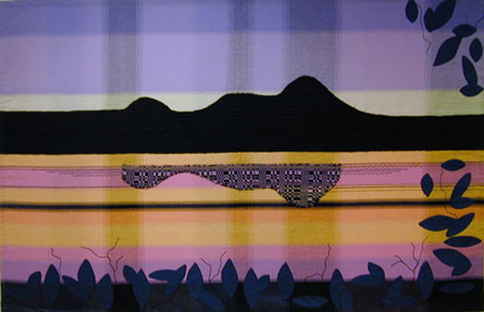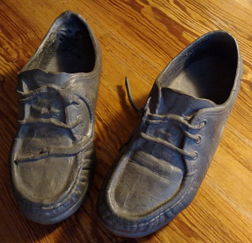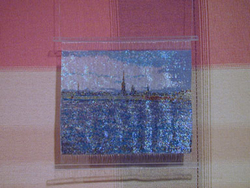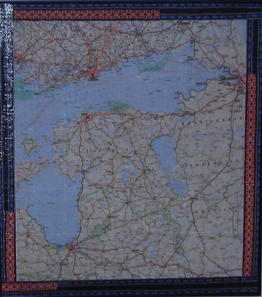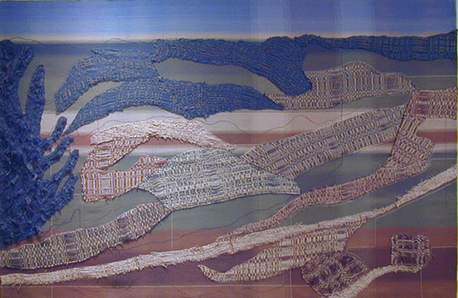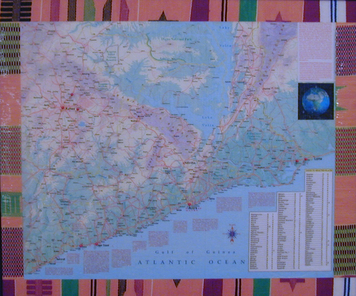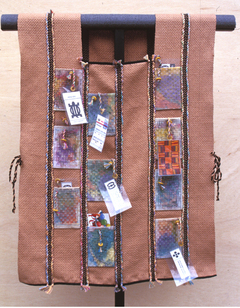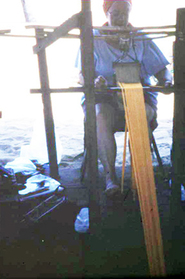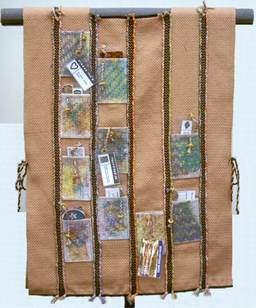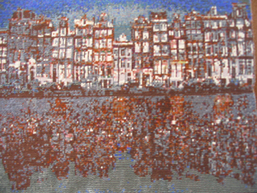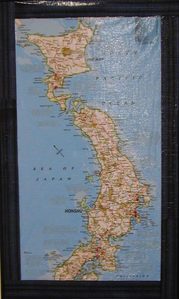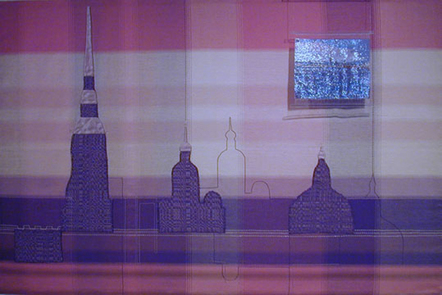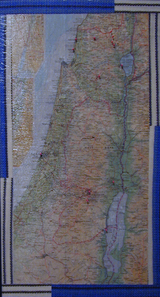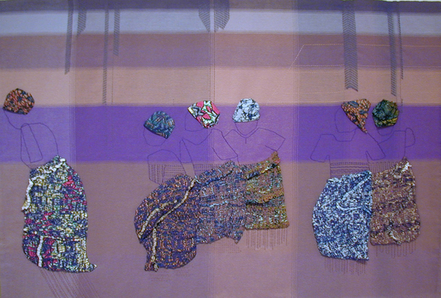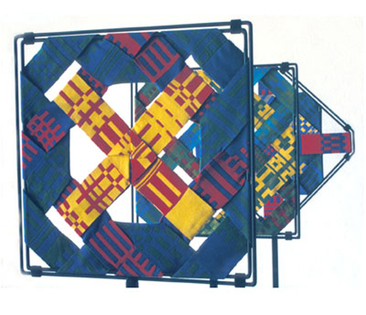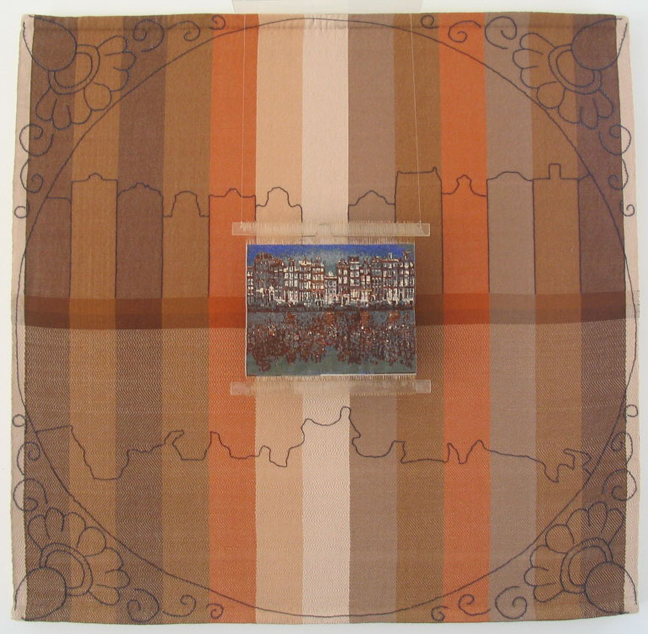Travel
GLOBAL NUANCES: 1993-2003: Japan, Russia, Israel, Ghana, and the Netherlands,
The work on this page focuses on the foreign travel I experienced between 1993 and 2003. This woven journey has become a metaphor for my life. The layered meaning of my experience may be seen through the layered cloth presented here. Photographic images inspire the four large panels. It was not my intention to replicate these photos in a literal sense but rather to interpret what I saw and to respond to each individually.
The woven background clothes form the groundwork which is then embellished with woven appliques and surface embroidery. The titles for each of the panels were used to create one-of-a-kind patterning within the appliques using a technique called “name drafts.” My “name drafts” patterns convert words into visual information, and they serve to illustrate the phrases I selected. The messages have personal significance particular to each place represented. Although you cannot “read” the messages, they add another layer of meaning to the cloth.
Embroidery serves to connect the ground and the surface additions. The running stitch and couching were used exclusively. The stitched lines help to lead the viewer’s eye through each weaving. Sometimes the line is organic in nature, and sometimes it follows the geometry of the ground cloth.
Each woven panel is accompanied by a polymer map of that country. Locations are marked showing stops made along each journey. I created these maps by applying multiple coats of clear acrylic gloss medium to the surface of a paper map. When I had achieved the desired thickness of the polymer, I removed the paper map. The image from the original map had been transferred to the polymer. The frames around the polymer maps were made the same way using xeroxes of woven textiles I had purchased in each of these countries. I cut the polymer “textiles” into stripes to frame the maps.
The trip I made to Ghana was specific to my textile interests and involved hands-on training with African master weavers and printers. Of all my foreign travel experiences, my trip to Ghana most profoundly affected my work and resulted in two additional works: “An American in Ghana” and “Remembering Ghana.”
“An American in Ghana” consists of 3 free-standing pieces and was inspired by Kente cloth, Ghana’s national identity. Traditionally Kente cloth is woven of long colorful 4-inch wide strips sewn together lengthwise to make a much wider cloth. My 4-inch wide strips are woven using double weave, and rather than lay the strips side by side, I manipulated them around metal frames to create shapes with open spaces through which parts of the piece behind can be seen. The double weave patterning was designed on the loom, alternating 4-inch sections of horizontal and vertical patterning meant to echo the nature of Kente cloth itself.
The tunic called “Remembering Ghana” was inspired by the Ghanaian war tunic, a garment covered with small amulet bags filled with powerful powders concocted to ensure the safety and success of the wearer. My tunic is handwoven using point twill weave designed to simulate the palm woven panels used in the construction of Ghanaian huts and fences. The appliqued pockets are made from copies of various maps of Ghana that are cut into strips and woven together. The items inside the pockets are little treasures I brought back from my trip: ticket stubs, food or beverage labels, Adinkra stamp symbols; all have been laminated and are attached to the pockets using hand-twisted cord and beads purchased in the Ghanaian markets.
My woven journey continued in 2003 when I saw Amsterdam for the first time.
The work on this page focuses on the foreign travel I experienced between 1993 and 2003. This woven journey has become a metaphor for my life. The layered meaning of my experience may be seen through the layered cloth presented here. Photographic images inspire the four large panels. It was not my intention to replicate these photos in a literal sense but rather to interpret what I saw and to respond to each individually.
The woven background clothes form the groundwork which is then embellished with woven appliques and surface embroidery. The titles for each of the panels were used to create one-of-a-kind patterning within the appliques using a technique called “name drafts.” My “name drafts” patterns convert words into visual information, and they serve to illustrate the phrases I selected. The messages have personal significance particular to each place represented. Although you cannot “read” the messages, they add another layer of meaning to the cloth.
Embroidery serves to connect the ground and the surface additions. The running stitch and couching were used exclusively. The stitched lines help to lead the viewer’s eye through each weaving. Sometimes the line is organic in nature, and sometimes it follows the geometry of the ground cloth.
Each woven panel is accompanied by a polymer map of that country. Locations are marked showing stops made along each journey. I created these maps by applying multiple coats of clear acrylic gloss medium to the surface of a paper map. When I had achieved the desired thickness of the polymer, I removed the paper map. The image from the original map had been transferred to the polymer. The frames around the polymer maps were made the same way using xeroxes of woven textiles I had purchased in each of these countries. I cut the polymer “textiles” into stripes to frame the maps.
The trip I made to Ghana was specific to my textile interests and involved hands-on training with African master weavers and printers. Of all my foreign travel experiences, my trip to Ghana most profoundly affected my work and resulted in two additional works: “An American in Ghana” and “Remembering Ghana.”
“An American in Ghana” consists of 3 free-standing pieces and was inspired by Kente cloth, Ghana’s national identity. Traditionally Kente cloth is woven of long colorful 4-inch wide strips sewn together lengthwise to make a much wider cloth. My 4-inch wide strips are woven using double weave, and rather than lay the strips side by side, I manipulated them around metal frames to create shapes with open spaces through which parts of the piece behind can be seen. The double weave patterning was designed on the loom, alternating 4-inch sections of horizontal and vertical patterning meant to echo the nature of Kente cloth itself.
The tunic called “Remembering Ghana” was inspired by the Ghanaian war tunic, a garment covered with small amulet bags filled with powerful powders concocted to ensure the safety and success of the wearer. My tunic is handwoven using point twill weave designed to simulate the palm woven panels used in the construction of Ghanaian huts and fences. The appliqued pockets are made from copies of various maps of Ghana that are cut into strips and woven together. The items inside the pockets are little treasures I brought back from my trip: ticket stubs, food or beverage labels, Adinkra stamp symbols; all have been laminated and are attached to the pockets using hand-twisted cord and beads purchased in the Ghanaian markets.
My woven journey continued in 2003 when I saw Amsterdam for the first time.
|
The focal point of “Amsterdam, The Netherlands” is an 8” x 10” bead weaving composed of 24,000 glass beads. The canal scene depicted in the bead weaving is repeated in embroidery on the woven background cloth, and the overall presentation suggests a Dutch Delph tile with decorative corners.
|
